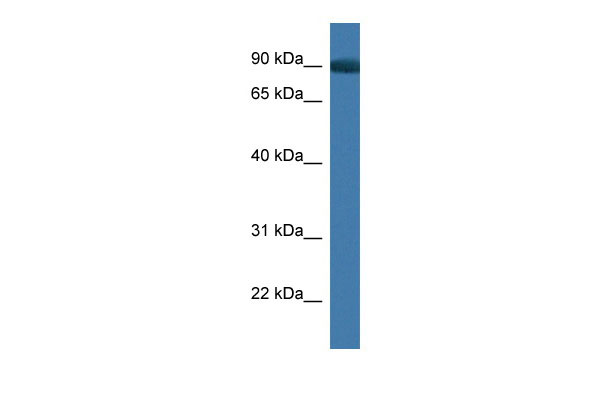App antibody - C-terminal region
Rabbit Polyclonal Antibody
- 产品详情
- 实验流程
Application
| WB |
|---|---|
| Primary Accession | P12023 |
| Other Accession | NM_001198824, NP_001185753 |
| Reactivity | Human, Mouse, Rat, Rabbit, Zebrafish, Dog, Guinea Pig, Horse, Bovine |
| Predicted | Human, Mouse, Rat, Zebrafish, Pig, Chicken, Dog, Guinea Pig, Horse, Bovine |
| Host | Rabbit |
| Clonality | Polyclonal |
| Calculated MW | 86722 Da |
| Gene ID | 11820 |
|---|---|
| Alias Symbol | Abeta, Abpp, Adap, Ag, betaApp, Cvap, E030013M08Rik |
| Other Names | Amyloid beta A4 protein, ABPP, APP, Alzheimer disease amyloid A4 protein homolog, Amyloidogenic glycoprotein, AG, N-APP, Soluble APP-alpha, S-APP-alpha, Soluble APP-beta, S-APP-beta, C99, APP-C99, Beta-amyloid protein 42, Beta-APP42, Beta-amyloid protein 40, Beta-APP40, C83, P3(42), P3(40), C80, Gamma-secretase C-terminal fragment 59, APP-C59, Amyloid intracellular domain 59, AID(59), Gamma-CTF(59), Gamma-secretase C-terminal fragment 57, APP-C57, Amyloid intracellular domain 57, AID(57), Gamma-CTF(57), Gamma-secretase C-terminal fragment 50, Amyloid intracellular domain 50, AID(50), Gamma-CTF(50), C31, App |
| Format | Liquid. Purified antibody supplied in 1x PBS buffer with 0.09% (w/v) sodium azide and 2% sucrose. |
| Reconstitution & Storage | Add 50 ul of distilled water. Final anti-App antibody concentration is 1 mg/ml in PBS buffer with 2% sucrose. For longer periods of storage, store at 20°C. Avoid repeat freeze-thaw cycles. |
| Precautions | App antibody - C-terminal region is for research use only and not for use in diagnostic or therapeutic procedures. |
| Name | App {ECO:0000312|MGI:MGI:88059} |
|---|---|
| Function | Functions as a cell surface receptor and performs physiological functions on the surface of neurons relevant to neurite growth, neuronal adhesion and axonogenesis. Interaction between APP molecules on neighboring cells promotes synaptogenesis. Involved in cell mobility and transcription regulation through protein-protein interactions. Can promote transcription activation through binding to APBB1-KAT5 and inhibit Notch signaling through interaction with Numb. Couples to apoptosis-inducing pathways such as those mediated by G(o) and JIP. Inhibits G(o)-alpha ATPase activity (By similarity). Acts as a kinesin I membrane receptor, mediating the axonal transport of beta- secretase and presenilin 1 (By similarity). By acting as a kinesin I membrane receptor, plays a role in axonal anterograde transport of cargo towards synapses in axons (By similarity). May be involved in copper homeostasis/oxidative stress through copper ion reduction. Can regulate neurite outgrowth through binding to components of the extracellular matrix such as heparin and collagen I and IV (By similarity). The splice isoforms that contain the BPTI domain possess protease inhibitor activity. Induces a AGER-dependent pathway that involves activation of p38 MAPK, resulting in internalization of amyloid-beta peptide and leading to mitochondrial dysfunction in cultured cortical neurons (By similarity). Provides Cu(2+) ions for GPC1 which are required for release of nitric oxide (NO) and subsequent degradation of the heparan sulfate chains on GPC1. |
| Cellular Location | Cell membrane; Single-pass type I membrane protein {ECO:0000250|UniProtKB:P05067} Membrane {ECO:0000250|UniProtKB:P05067}; Single-pass type I membrane protein {ECO:0000250|UniProtKB:P05067}. Perikaryon {ECO:0000250|UniProtKB:P08592}. Cell projection, growth cone {ECO:0000250|UniProtKB:P08592}. Membrane, clathrin-coated pit {ECO:0000250|UniProtKB:P05067}. Early endosome. Cytoplasmic vesicle {ECO:0000250|UniProtKB:P05067}. Golgi apparatus, trans-Golgi network. Note=Cell surface protein that rapidly becomes internalized via clathrin-coated pits. Only a minor proportion is present at the cell membrane; most of the protein is present in intracellular vesicles. During maturation, the immature APP (N-glycosylated in the endoplasmic reticulum) moves to the Golgi complex where complete maturation occurs (O-glycosylated and sulfated) After alpha-secretase cleavage, soluble APP is released into the extracellular space and the C-terminal is internalized to endosomes and lysosomes. Some APP accumulates in secretory transport vesicles leaving the late Golgi compartment and returns to the cell surface. APP sorts to the basolateral surface in epithelial cells. During neuronal differentiation, the Thr-743 phosphorylated form is located mainly in growth cones, moderately in neurites and sparingly in the cell body Casein kinase phosphorylation can occur either at the cell surface or within a post-Golgi compartment (By similarity). Associates with GPC1 in perinuclear compartments (PubMed:15677459). Colocalizes with SORL1 in a vesicular pattern in cytoplasm and perinuclear regions (By similarity). Upon neuronal activation, routed into BACE1-positive recycling endosomes via a clathrin -dependent mechanism (PubMed:23931995). {ECO:0000250|UniProtKB:P05067, ECO:0000269|PubMed:15677459, ECO:0000269|PubMed:23931995} [C83]: Endoplasmic reticulum {ECO:0000250|UniProtKB:P05067}. Golgi apparatus {ECO:0000250|UniProtKB:P05067}. Early endosome {ECO:0000250|UniProtKB:P05067} [Amyloid-beta protein 42]: Cell surface. Note=Associates with FPR2 at the cell surface and the complex is then rapidly internalized. {ECO:0000250|UniProtKB:P05067} |
| Tissue Location | Expressed in the brain with expression in cortex, cerebellum, hippocampus, olfactory bulb, neurons, astrocytes and microglia (at protein level) (PubMed:25757569, PubMed:26260791, PubMed:28720718). Expressed in the retinal lens (PubMed:25757569) Expressed at a low level in muscle cells (at protein level) (PubMed:25757569). [Isoform APP751]: Widely expressed (PubMed:8510506). Expressed in several different brain regions including hippocampus, substantia nigra pars compacta and cerebellum (PubMed:8510506). Within the cerebellum, abundantly expressed in Purkinje cells (PubMed:8510506). [Isoform APP714]: Expressed in several different brain regions including hippocampus, substantia nigra pars compacta and cerebellum (PubMed:8510506). Within the cerebellum, abundantly expressed in Purkinje cells (PubMed:8510506) |
Research Areas
For Research Use Only. Not For Use In Diagnostic Procedures.
Application Protocols
Provided below are standard protocols that you may find useful for product applications.
REFERENCES
Yamada T.,et al.Biochem. Biophys. Res. Commun. 149:665-671(1987).
Yamada T.,et al.Submitted (MAR-1988) to the EMBL/GenBank/DDBJ databases.
de Strooper B.,et al.Biochim. Biophys. Acta 1129:141-143(1991).
Kumar V.B.,et al.Biochem. Cell Biol. 79:57-67(2001).
Izumi R.,et al.Gene 112:189-195(1992).
终于等到您。ABCEPTA(百远生物)抗体产品。
点击下方“我要评价 ”按钮提交您的反馈信息,您的反馈和评价是我们最宝贵的财富之一,
我们将在1-3个工作日内处理您的反馈信息。
如有疑问,联系:0512-88856768 tech-china@abcepta.com.























 癌症的基本特征包括细胞增殖、血管生成、迁移、凋亡逃避机制和细胞永生等。找到癌症发生过程中这些通路的关键标记物和对应的抗体用于检测至关重要。
癌症的基本特征包括细胞增殖、血管生成、迁移、凋亡逃避机制和细胞永生等。找到癌症发生过程中这些通路的关键标记物和对应的抗体用于检测至关重要。 为您推荐一个泛素化位点预测神器——泛素化分析工具,可以为您的蛋白的泛素化位点作出预测和评分。
为您推荐一个泛素化位点预测神器——泛素化分析工具,可以为您的蛋白的泛素化位点作出预测和评分。 细胞自噬受体图形绘图工具为你的蛋白的细胞受体结合位点作出预测和评分,识别结合到自噬通路中的蛋白是非常重要的,便于让我们理解自噬在正常生理、病理过程中的作用,如发育、细胞分化、神经退化性疾病、压力条件下、感染和癌症。
细胞自噬受体图形绘图工具为你的蛋白的细胞受体结合位点作出预测和评分,识别结合到自噬通路中的蛋白是非常重要的,便于让我们理解自噬在正常生理、病理过程中的作用,如发育、细胞分化、神经退化性疾病、压力条件下、感染和癌症。






